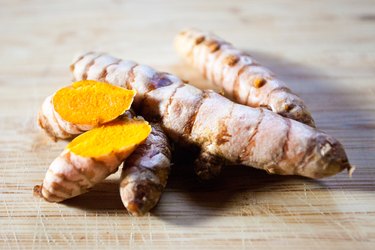
Turmeric's earthy aroma and flavor make it a delicious addition to many dishes. Turmeric is almost always sold with the dried spices at grocery stores, but some specialty markets carry the fresh root. Swapping fresh turmeric root for dried in recipes is possible.
According to Michigan State University, turmeric has multiple uses. It is used in food for to add both color and flavor. Fresh turmeric is grown throughout India and other areas in Asia, as well as Central America.
Video of the Day
Video of the Day
It is also used as a dye and as a component of some medicinal remedies. While typically consumed in powder form, fresh turmeric is a viable substitution.
Read more: Benefits of Turmeric Powder
Know the Health Benefits
Adding fresh turmeric to your foods has several health benefits. According to an article published in June 2018 by Journal of Pharmacognosy and Phytochemistry, turmeric is a strong antioxidant that also has anti-inflammatory, antibacterial, antifungal and cholesterol lowering effects.
According to the Linus Pauling Institute at Oregon State University, curcumin — the biologically active component of turmeric — has been shown to inhibit cancer cell growth in animal studies, but these findings have yet to be confirmed in human research studies.
According to the National Center for Complementary and Integrative Health, preliminary studies suggest turmeric might reduce skin irritation after radiation treatment, reduce pain from osteoarthritis and reduce risk of heart attacks in people after bypass surgery.
Using Fresh Turmeric
Fresh herbs and spices are almost always more desirable than their dried counterparts, and turmeric is no exception. Fresh turmeric is less bitter than dried turmeric. To successfully use fresh turmeric, wash the root of any dirt and scrub it well.
You don't need to peel the turmeric, though some people prefer to. You can grate it with a microplane, ginger grater or the small side of a cheese grater. Turmeric can also be smashed with a garlic press or pestle and mortar.
Use Conversion Ratios
The general rule of thumb for converting dried herbs or spices to fresh in a recipe is 1-to-3, according to Colorado State University. Approximately 1 teaspoon of dried turmeric is equal to 3 teaspoons — 1 tablespoon — of fresh turmeric.
Store It Properly
Store fresh turmeric in the fridge, wrapped loosely so it doesn't mold. You can also freeze turmeric. It will be mushy when it thaws out, but fine to add to your dish.
Freeze it in usable sizes — pieces that are 1 to 1.5 inches, as recommended by North Carolina State University, so you can defrost just the amount you will use at one time.
Read more: What Are the Benefits of Turmeric Capsules?
Follow These Precautions
Turmeric is bright yellowish-orange and will stain surfaces and fingers, especially in its fresh form. Wear gloves while grating it if you don't want yellow fingertips.
While turmeric in food is considered safe, talk to your doctor before eating large doses or considering taking it as a supplement. According to the National Center for Complementary and Integrative Health, ingesting large amounts of turmeric, or using it for medicinal purposes long-term can lead to gastrointestinal problems.
- Journal of Phamacognosy and Phytochemistry: "Studies on Evaluation of Physicochemical and Nutritional Properties of Fresh Turmeric Rhizome"
- Michigan State University: "Health Benefits of Turmeric"
- Linus Pauling Institute: "Curcumin"
- Colorado State University: "Herbs: Preserving and Using"
- North Carolina State University: "Ginger and Turmeric: Tropical Superfoods for the Garden"
- National Center for Complementary and Integrative Health: "Turmeric"
- The Cook's Thesarus: Ginger and Other Rhizomes